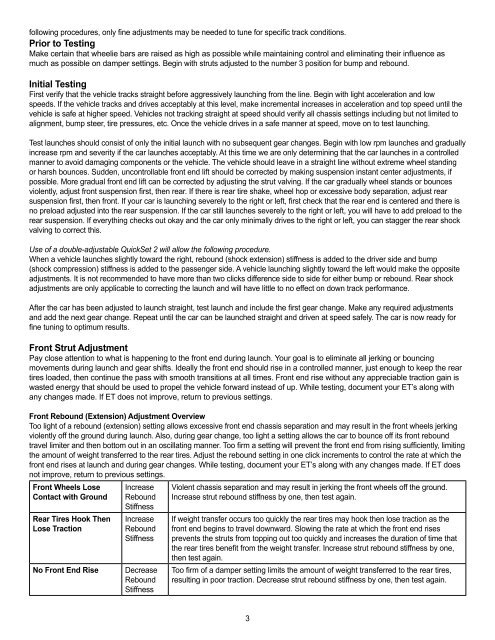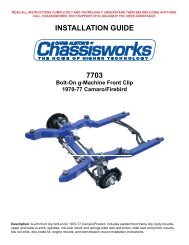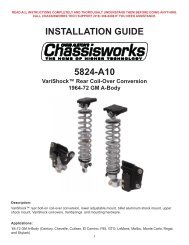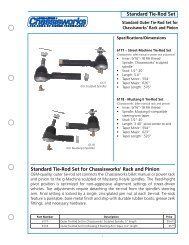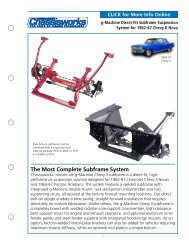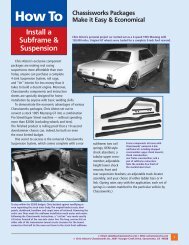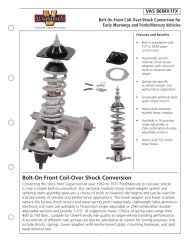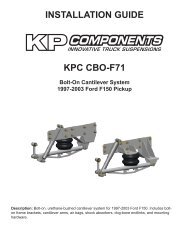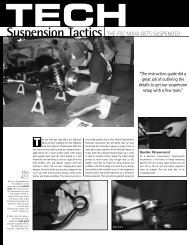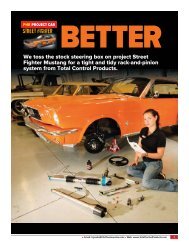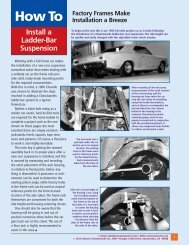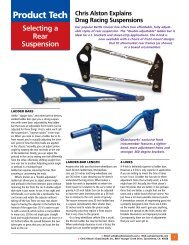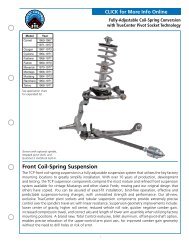VariStrut Adjustment and Tuning Guide - Chris Alston's Chassisworks
VariStrut Adjustment and Tuning Guide - Chris Alston's Chassisworks
VariStrut Adjustment and Tuning Guide - Chris Alston's Chassisworks
You also want an ePaper? Increase the reach of your titles
YUMPU automatically turns print PDFs into web optimized ePapers that Google loves.
following procedures, only fine adjustments may be needed to tune for specific track conditions.Prior to TestingMake certain that wheelie bars are raised as high as possible while maintaining control <strong>and</strong> eliminating their influence asmuch as possible on damper settings. Begin with struts adjusted to the number 3 position for bump <strong>and</strong> rebound.Initial TestingFirst verify that the vehicle tracks straight before aggressively launching from the line. Begin with light acceleration <strong>and</strong> lowspeeds. If the vehicle tracks <strong>and</strong> drives acceptably at this level, make incremental increases in acceleration <strong>and</strong> top speed until thevehicle is safe at higher speed. Vehicles not tracking straight at speed should verify all chassis settings including but not limited toalignment, bump steer, tire pressures, etc. Once the vehicle drives in a safe manner at speed, move on to test launching.Test launches should consist of only the initial launch with no subsequent gear changes. Begin with low rpm launches <strong>and</strong> graduallyincrease rpm <strong>and</strong> severity if the car launches acceptably. At this time we are only determining that the car launches in a controlledmanner to avoid damaging components or the vehicle. The vehicle should leave in a straight line without extreme wheel st<strong>and</strong>ingor harsh bounces. Sudden, uncontrollable front end lift should be corrected by making suspension instant center adjustments, ifpossible. More gradual front end lift can be corrected by adjusting the strut valving. If the car gradually wheel st<strong>and</strong>s or bouncesviolently, adjust front suspension first, then rear. If there is rear tire shake, wheel hop or excessive body separation, adjust rearsuspension first, then front. If your car is launching severely to the right or left, first check that the rear end is centered <strong>and</strong> there isno preload adjusted into the rear suspension. If the car still launches severely to the right or left, you will have to add preload to therear suspension. If everything checks out okay <strong>and</strong> the car only minimally drives to the right or left, you can stagger the rear shockvalving to correct this.Use of a double-adjustable QuickSet 2 will allow the following procedure.When a vehicle launches slightly toward the right, rebound (shock extension) stiffness is added to the driver side <strong>and</strong> bump(shock compression) stiffness is added to the passenger side. A vehicle launching slightly toward the left would make the oppositeadjustments. It is not recommended to have more than two clicks difference side to side for either bump or rebound. Rear shockadjustments are only applicable to correcting the launch <strong>and</strong> will have little to no effect on down track performance.After the car has been adjusted to launch straight, test launch <strong>and</strong> include the first gear change. Make any required adjustments<strong>and</strong> add the next gear change. Repeat until the car can be launched straight <strong>and</strong> driven at speed safely. The car is now ready forfine tuning to optimum results.Front Strut <strong>Adjustment</strong>Pay close attention to what is happening to the front end during launch. Your goal is to eliminate all jerking or bouncingmovements during launch <strong>and</strong> gear shifts. Ideally the front end should rise in a controlled manner, just enough to keep the reartires loaded, then continue the pass with smooth transitions at all times. Front end rise without any appreciable traction gain iswasted energy that should be used to propel the vehicle forward instead of up. While testing, document your ET’s along withany changes made. If ET does not improve, return to previous settings.Front Rebound (Extension) <strong>Adjustment</strong> OverviewToo light of a rebound (extension) setting allows excessive front end chassis separation <strong>and</strong> may result in the front wheels jerkingviolently off the ground during launch. Also, during gear change, too light a setting allows the car to bounce off its front reboundtravel limiter <strong>and</strong> then bottom out in an oscillating manner. Too firm a setting will prevent the front end from rising sufficiently, limitingthe amount of weight transferred to the rear tires. Adjust the rebound setting in one click increments to control the rate at which thefront end rises at launch <strong>and</strong> during gear changes. While testing, document your ET’s along with any changes made. If ET doesnot improve, return to previous settings.Front Wheels LoseContact with GroundRear Tires Hook ThenLose TractionNo Front End RiseIncreaseReboundStiffnessIncreaseReboundStiffnessDecreaseReboundStiffnessViolent chassis separation <strong>and</strong> may result in jerking the front wheels off the ground.Increase strut rebound stiffness by one, then test again.If weight transfer occurs too quickly the rear tires may hook then lose traction as thefront end begins to travel downward. Slowing the rate at which the front end risesprevents the struts from topping out too quickly <strong>and</strong> increases the duration of time thatthe rear tires benefit from the weight transfer. Increase strut rebound stiffness by one,then test again.Too firm of a damper setting limits the amount of weight transferred to the rear tires,resulting in poor traction. Decrease strut rebound stiffness by one, then test again.


